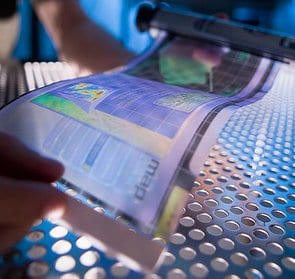Polymers can assemble forming uniform layers that feature percolation pathways for efficient charge transport. Small molecules form highly crystalline assemblies with overlap between adjacent molecules leading to high charge mobility. Writing in the Journal of Polymer Science: Polymer Physics, Paolo Samori and colleagues show that by combining the advantages of both polymers and small molecules as semiconductors in organic electronics, charge transport can be greatly improved.
Traps present at crystal boundaries act as a bottleneck for charge transport. By gaining control over the final morphology of the film, the effect of the traps is minimized, maximizing charge transport. “Here the challenge is to be able to exploit the advantages of both classes [of material] selecting the most suitable blend and processing [both] using appropriate boundary conditions (e.g. relative concentration, solvent, deposition method, etc.)” says Samori. “We show that only a little amount of crystalline material can markedly improve the charge carrier mobility of semiconducting film.”
In this work, the authors blend poly(3-hexylthiophene) (P3HT), a conjugated polymer, and alkyl-substituted bisphenyl-bithiophene[phenylene-thiophene-thiophene-phenylene (PTTP)], a small conjugated molecule. The results were studied using optical microscopy (OM), atomic force microscopy (AFM), and Kelvin probe force microscopy (KPFM), making it possible to map both the electronic and structural properties of the materials.
The researchers faced the problem of finding the peak performance concentration since the concentration of PTTP had to be high enough to create highly branched percolation paths in the polymer but not so high as to induce phase separation. Their best results were obtained with a PTTP concentration of 3 to 5%.
“In the paper we studied the electrical properties of the blend and how they vary with the relative concentration of the component but I think that this approach can be used in principle to study a wide range of properties, spanning from mechanical to optical.” explains Samori. “A little amount of material can lead to a large property change! This represents an interesting and cheap approach as it shows that it is possible to tune some properties of cheap materials by using only a small quantity of a more performing and expensive one.”
“As often happens in explorative research, one discovery opens many questions” he continues. “Why the highest mobility is achieved for a little percentage of the small molecule? The idea that disorder can be exploited to improve the charge transport in blend suggests that the electrical properties are strongly intertwined with the morphological ones. Mixing molecules conveying distinct properties represents an avenue towards multifunctional materials.”
Thumbnail image: flickr.com/RDECOM / CC BY 2.0


















